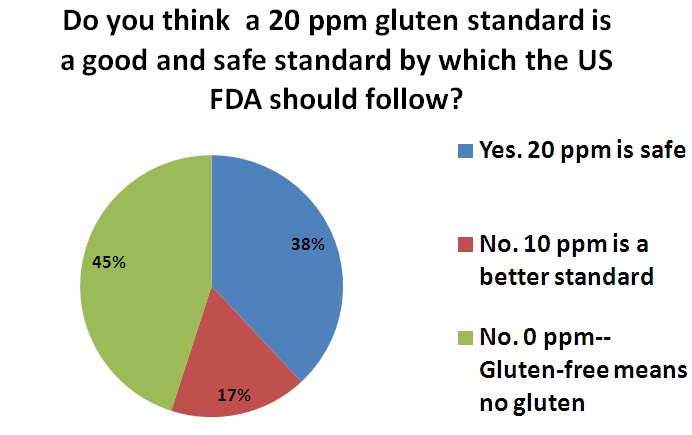Survey: Most say Gluten-Free Standards Should Mean Zero Gluten
July 6, 2009 by Amy Leger | G+ Amy LegerWhen does gluten-free actually mean zero gluten? You think that would be an easy question. But in the last couple of years the Food and Drug Administration has taken this question on as it explores creating rules for enforcing voluntary gluten-free labeling.
Right now, it is considering allowing a company to label a product gluten-free if it tests below 20 parts per million (ppm) of gluten. The FDA’s announcement regarding all gluten-free labeling has been delayed for the last year, but it is expected to come out sometime this summer.
Because of the timeliness of the issue, thesavvyceliac.com did an unscientific survey of the celiac community asking several questions about the proposed 20 ppm gluten standard; including this question: Do you think a 20 ppm gluten standard is a good and safe standard by which the US FDA should follow?

100 people responded to the survey which was conducted in late June of 2009. 45%– most of the respondents– said the proposal was not a safe standard that the FDA should follow. These respondents believe 0 gluten should be the standard because “gluten-free means no gluten”. 38% agreed that the 20 ppm standard was good for celiacs. While 17% said no, the 20 ppm was too liberal and preferred a 10 ppm standard.
Gluten-free means no gluten
“I have a huge problem when products that actually CONTAIN gluten are labeled gluten-free,” one respondent commented. In that respondent’s case like others in the 45% range, it is “the principal of the thing” that bothers them. “You would not say ‘peanut-free’ and put a small amount [of peanuts] in,” another respondent said.
Others were concerned about confusion on the amount of gluten they would be ingesting if they had several products that tested under 20 ppm in one day. One person said “People would have to be VERY aware of portion sizes.” While another said, “I don’t want to have to do math computations to add my ‘ppm’ per serving or day.”
One respondent was downright angry, “I GET SICK when I have even a trace of gluten, so this means my asinine government will be creating an entire bevy of products whose sole purpose is to make me continuously, violently ill…if they go through with this idiotic plan [the federal government is] asking for a major class-action lawsuit.”
Several respondents mentioned technology may not actually be able to test to 0 ppm. The Gluten Free Certification Organization confirms this on its website saying “No testing method is available that measures to zero.” This doesn’t mean it isn’t something to strive for however.
Okay with 10 ppm standard
While 10 ppm isn’t on the table for the FDA’s proposed standard, we asked the question to gauge whether somewhere in between 20 and 0 would be acceptable. 17% of you agreed. “I get sick at the 20 ppm level, but not at 10 ppm or less.” Another person wrote, “We currently buy from several companies who test for the 20 ppm, but I think 10 ppm would be a better fit for gluten-free. I don’t think 0 ppm is realistic.”
20 ppm standard is good
Of the 38% who agreed with the proposed FDA gluten standard, some put their faith in history and science. “It is the international standard,” one respondent wrote, “Really the US has no standard and should come in line with the rest of the world.” Another person said, “20 ppm is nondetectable when tested.”
While others worry about what will happen to gluten-free foods if we don’t accept the 20 ppm standard. “I’m afraid that if people try ot push the level to something lower than that, the food manufacturers will balk and not even try to accommodate the gluten-free community.” Another person said “Setting an unrealistic lower limit will mean that manufacturers will just not label their foods at all, which helps no one. A testable higher limit that manufacturers can obey is better than an untestable one that forces them to not label GF foods.”
Summing it up
One thing I think we all agree on is that some labeling needs to be done. I personally would prefer mandatory labeling over voluntary, but that’s not up for discussion. As for the ppm debate, I’m torn. I have one part of me that says “Duh, gluten-free needs to be free of gluten”, the other part of me wants to believe in the science that says foods below 20 ppm is acceptable and safe. I know my daughter, Emma, and our former exchange student, Ida, have had the Chex cereals which test below 20 ppm and have had no problem with them at all. But other people say they do.
It is a debate that won’t be solved here, but certainly a topic worth talking about. More on this topic to come…
*For more background on 20 ppm, check out a recent post on thesavvyceliac.com



Leave a Reply